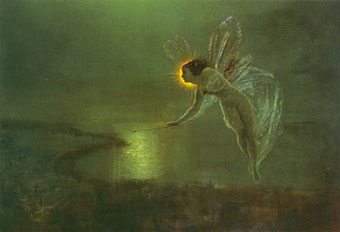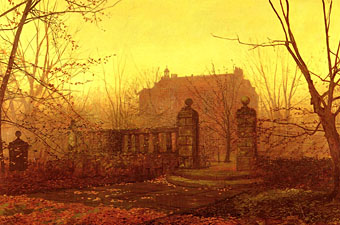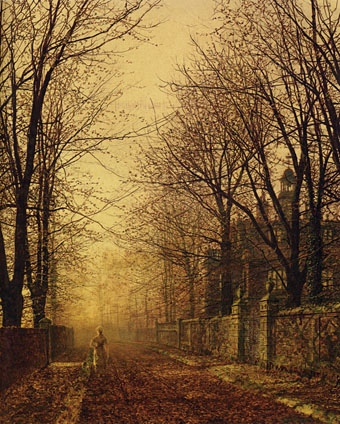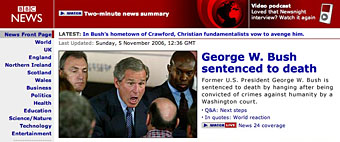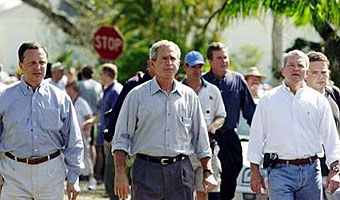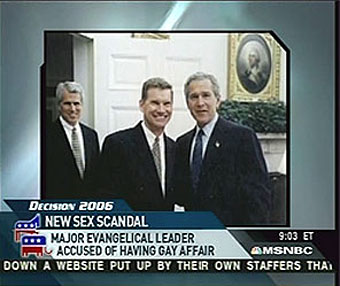
Left: Michael Jones.
Irony abounds. In the Protect-me-from-what-I-want Dept, Pastor Ted Haggard gave this sermon four days before his gay liaisons were brought to light: “Heavenly Father give us grace and mercy, help us this next week and a half as we go into national elections and Lord we pray for our country. Father we pray lies would be exposed and deception exposed. Father we pray that wisdom would come upon our electorate…” Who says prayer doesn’t work?
Michelangelo Signorile has a show on Sirius Satellite Radio’s OutQ, America’s gay radio station (2-6 pm EST). Today he interviews Michael Jones, the escort whose meetings with Pastor Ted caused the evangelical leader’s fall from grace last week. Here’s an extract.
Michelangelo Signorile: I’m here with Michael Jones, the man who of course is at the center of enormous controversy. We’re in New York City, at the Waldorf-Astoria. He came to New York do the Today show.
What was that like flying in just to do the Today show about all of this, and then flying out?
Michael Jones: Well, in the last three days I’ve had three hours of sleep, so I’m exhausted. The whole process has been highly educational for me, but it’s grueling.
MS: Tell me a bit about how you first met Ted Haggard.
MJ: It was approximately three years ago. Got a call from a gentleman who said his name was Art. He wanted to see if we could hook up. At the time I was advertising as an escort in gay publications. I only advertised in gay publications. So if someone was looking for me, they were looking in a gay publication. He said he was from Kansas City and he wanted to hook up. We hooked up at my place. Always at my place. I had never been to a hotel with him.
MS: Did he use the term “hook up?” I mean, what did he actually say he wanted to do?
MJ: He said he wanted an appointment with me. He came to my apartment. And the clothes came right off. The first time it was pretty much mutual masturbation, then in time oral sex. He was really pretty vanilla. Only once in three years did we try anal sex.
MS: Was he a top or bottom? What was he interested in?
MJ: When I was on the radio show in Denver, the question was asked: Did you practice safe sex? I said, “We used a condom once.” The talk show host goes, “You mean he wore the condom once?” I said, “Uh, no, I did.”
MS: What about with oral sex. Was he the passive partner or the active partner?
MJ: You know, it kind of went back and forth ? and I can’t say he was very good at it.
MS: Did he seem like he’d done this before?
MJ: I don’t know. He didn’t appear nervous to me. He was very quiet. Didn’t talk much. Liked the lights low. He never was with me for more than an hour. Sometimes it was just 15 or 20 minutes.
MS: Did he want companionship or was it all sex?
MJ: It was pretty much in and out. Sex, no speaking. Do the thing, and then he left. I could see the street from where I live and I could see he would park a block away and when he would call me he would block the calls, at least in that in the first year. After that first year he started calling me from pay phones and I noticed the area code was Colorado Springs.
***
MS: And you’d had people who came from Colorado Springs, which is of course the center of evangelical movement, who were involved with the churches?
MJ: I can’t tell you how many ministers, pastors, priests I’ve had. It didn’t bother me, nothing surprised me. And when I saw that his calls were coming from Colorado Springs I figured he was involved with the church. But I was shocked that this guy, how huge he was, and taking such a risk.
MS: You felt that you had to do something before November 7th, if it was going to impact Amendment 43 and the elections.
MJ: And I don’t know if it’s going to change votes at all. I don’t know what the outcome will be, it coming out before the election but I Had to point out the hypocrisy, that here is a gentleman enjoying all the benefits of marriage, all the rights and doesn’t want two other people of the same sex who love each other to have those same rights and yet he can cheat on his wife.
MS: How did you go about reaching out to media?
MJ: Two months before it actually came out, I went to this reporter in Denver [at the NBC affiliate, Channel 9] who I respected, and investigative reporter who was well known. I went to her and immediately the station congregated around me. They go, “This is huge, we want this story!” But they go, “We need just a little bit more proof.” They actually wanted to see film of him and me together somehow. They wanted some video of some type. And I was prepared to do that. I had video cameras lined up. I was going to hide them in my apartment. But Ted wasn’t calling me after that last get together in August. My gut feeling was, with the Foley thing happening, and the election happening, he wanted to lay low.
MS: Did he always have an orgasm when he was with you?
MJ: Yes.
MS: And I guess if you were going to pursue this, to get more evidence, you were going to collect some of that DNA evidence. Was that part of the plan?
MJ: Boy, you hit it right on the head.
MS: But he all of a sudden wasn’t calling you, out of the blue? You would meet once per month, but how often did he call?
MJ: Once per month, when he wanted to meet.
MS: So August was the last time he called. You would of course need the opportunity in September or October to film him and have more evidence before the election.
MJ: Right, and it wasn’t happening. So I was listening to Peter Boyles, our big talk show host in Denver. And the subject was gay marriage. And I was hearing all the right wingers calling in and I was getting pissed. I knew I was sitting on this story – it was eating at me. I sent Peter an email and said, if you want a big story I have a big story for you. Well, two days later, they said, “Can you be on the radio at 6 a.m. tomorrow?”
I didn’t reveal Ted Haggard’s name. I wasn’t ready to reveal the name. All the callers were calling in and saying I just wanted publicity. Well, when Channel 9 heard me on the radio, they wanted the story so bad, they went down to Colorado Springs and they confronted Haggard, and then ran the story. That’s how it really broke.
MS: So they really are the ones who outed him, after you spoke on the radio about “a preacher.”
MJ: That’s right.
***
MS: Tell me about this: You’re having sexual encounters with him once a month. After about a year he just asks you about crystal meth?
MJ: He just goes, “Hey Mike, I have a question. What do you know about crystal meth?” I was a little bit surprised. I said, “I don’t care for it. I’ve tried it but I don’t care for it. But I have friends who do it and they think it enhances their sexual pleasure.” He goes, “Do you think you can get me some?” I told him I’ll see what I can do.
MS: And you hooked him up with somebody who could get him this drug. Then what? He would do it in your presence when he had sex with you?
MJ: Yes, he agreed it enhanced his pleasure and said that he used it when he had sex with his wife too.
MS: What did he get like after he took the crystal? How did it impact him?
MJ: I can’t get into his mind or his body. He didn’t act any differently. He seemed to be enjoying it. Definitely had a smile on his face.
MS: He said he was taking this when he had sex with his wife. Did he indicate he had trouble having sex with his wife? Did it allow him to have heterosexual sex more easily? Is he gay, bisexual, any ideas on that?
MJ: I really don’t know. I really think he is a gay man. When you’re in that business, you’ve got to put up a good front. I think he has enormously strong homosexual tendencies but he just told me the drug enhanced his pleasure with his wife. I don’t know if he even really was having sex with his wife, or just said that. I think part it too is that he was a very busy man, traveling all over the country and the world. I think he enjoyed the drug too because it kept him going.
***
MS: You spoke about a fantasy he told you, his sexual fantasy. Tell me about that?
MJ: This was the only time he ever spoke about something sexual other than being with me. He goes, “Mike do you know any young college guys” I said, “Well, I know a few, why? “He said, ‘I would love to get about 4 to 6 young college guys, about 18 to 22, I’d love to have group sex with them.’ I said, “Let me check around and see what I can do and see if I can organize that for you.” I never pursued it.
MS: What have you been hearing from people in response to what you’ve done?
MJ: Well, I’ve had hundreds and hundreds of phone calls coming in. Deluged, saying, “Thank you Mike. God you got balls!” A lot of thank yous. I have had one threatening phone call ? “You’re going to be so sorry for what you did. You’re going to get it.”
MS: Some people see you as a hero, others say, “He’s not a hero, he’s a prostitute.” What’s your reaction?
MJ: I don’t feel like a hero. I wasn’t trying to be a hero. I’m at the age of 49. I saw a lot of my friends going through hell in years past, where one of the partners would die and the other family would come in and say get out of the way, and just rape the house, and there was a lot of crying. I felt like this was a responsibility to my fellow gay brothers to do this. I’ve had some people say “You’re an immoral whore, bitch, fag.” But I’ve been called all those names all my life. So it’s not new. But I will tell you, when it finally broke, when he resigned, I have to be honest with you, I just broke down. I had so much emotion for so long.
MS: Do you feel other hustlers, like those in Washington DC, whose clients have been rightwing antigay politicians, should look to you like a role model and do the same thing?
MJ: I don’t think I should be a role model, but if I saw some politician out there bashing gays, yes, I think they should say something. But I would say, after going through this experience, I would say to them, just make sure you are able to prove it! [laughs]
Via AmericaBlog.
Previously on { feuilleton }
• All the President’s (gay) men
• Gay for God

